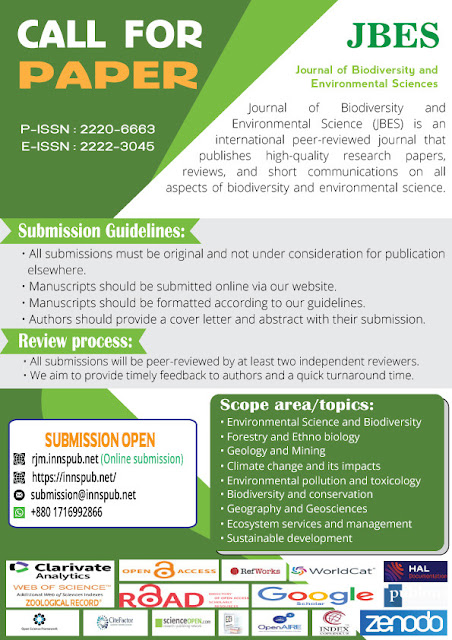Christy Achtone Nkollo-Kema Kema, Judicael Régis Kema Kema, Igor Akendengue Aken, Mariella Nzambe, Anaclet Mombo, and Christophe Roland Zinga Koumba, from the different institute of the Gabon. wrote a research article about, Manatee Capture and Release: First Documentation in Rogolié River Wetland, Gabon. entitled, First documentation of the capture and release of a manatee in the Rogolié River wetland (Ntoum, Gabon). This research paper published by the Journal of Biodiversity and Environmental Sciences (JBES). an open access scholarly research journal on Biodiversity under the affiliation of the International Network For Natural Sciences | INNSpub. an open access multidisciplinary research journal publisher.
Abstract
A large number of marine mammals are seriously threatened by fisheries. Although the issue of by-catches in fisheries is a major threat to marine mammals, it has not yet been tackled in a concrete way in Gabon. Artisanal fishing accounts for 95% of fishing activity. Their impact on vulnerable megafauna can therefore be significant, either as bycatch or as target species. However, detailed information on the composition of fisheries catches is limited because of a lack of monitoring and reporting due to limited financial and logistical capacity. The aim of this paper is to document a rare phenomenon of the release of an African manatee (Trichechus senegalensis) caught in fishing nets at the mouth of the Rogolié River in the Gabon estuary.
Read more : Baichi (Flacourtiaindica) Morpho-physiological Characteristics and Yield | InformativeBD
Introduction
Of all sirenians
species the West African manatee (Trichechus senegalensis) is the least well
known biologically (Reynolds and Odell 1991). The species is considered
vulnerable by the IUCN (Keith Diagne, 2015) due to the persistence of a wide
range of threats, primarily of human-induced. This species occurs in most of
the coastal marine waters, brackish estuaries, and adjacent rivers along the
West African coast from southern Mauritania (16°N) to the Cuanza and Longa
Rivers in Angola (9°S) (Dodman et al. 2008; Perrin 2001; Powell 1996; Grigione
1996; Nishiwaki 1984; Husar 1978; Robinson 1971; Blancou 1960; Beal 1939).
Gabon may have one of the highest densities of Manatees remaining in Africa (Nkollo
2022; Powell 1996). The decline of the Trichechus senegalensis population has
been largely attributed to hunting and incidental capture in fishing nets
(Dodman et al. 2008; Blancou 1960; Cadenat, 1957).
Bycatch in fishing gear
is also a major threat in all African countries, and even when caught alive,
most manatees caught incidentally are not released, but killed (Nkollo 2017;
Mbina 2001).
The aim of this note is
to document the phenomenon of accidental captures and rescue efforts for the
African manatee, a vulnerable species. We believe that the lessons learned from
this event can be beneficial to manatee conservation stakeholders and can
contribute to the development of better manatee release practices.
Reference
Auil N. 1998.
Belize manatee recovery plan. UNDP/GEF Coastal Zone Management Project, Belize
(BZE/92/G31). 67 pp
Beal WP. 1939.
The manatee as a food animal. Nigerian. Field 8, 124-126.
Blancou L. 1960.
Destruction and Protection of the fauna of French Equatorial and of French West
Africa. African Wildlife 14, 241-244.
Cadenat J. 1957.
Observations de cétacés, siréniens, cheloniens et sauriens en 1955-1956.
Bulletin IFAN 19(A), 1358-1383.
Dodman T, Angola In,
Dodman T, Diop MD, Sarr K. 2008a. Conservation strategy for the West
African Manatee, UNEP, Nairobi, Kenya and Wetlands International Africa, Dakar,
Senegal.
Domning DP, Marsh H,
O’Shea TJ, Reynolds III JE. 2011. Ecology and Conservation of the Sirenia:
Dugongs and Manatees. Cambridge University Press, Cambridge, United Kingdom,
536 pp. Series : Conservation Biology No. 18. ISBN-978-0-521-88828-8. Journal
of Mammalogy 93(5), 1405‑1406. https://doi.org/10.1644/12-mamm-r-126.1
Grigionemm. 1996.
Observations on the status and distribution of the West African manatee in
Cameroon. African Journal of Ecology 34(2), 189‑195. https://doi.org/10.1111/j.1365-2028.1996.tb
Husar SL. 1978. Trichechus
senegalensis, Mammalian Species 89, 1-3.
Keith L, Collins
T. 2007. Report on West African Manatee (Trichechus senegalensis) survey
activities in Gabon 2007, Wildlife Trust in association with Tim Collins,
WCS-Marine Program p. 14
Keith-Diagne L. 2015. Trichechus
senegalensis. The IUCN Red List of Threatened Species 2015:
e.T22104A97168578. http://dx.doi.org/10.2305/IU
CN. UK.2015-4.RLTS.T22104A81904980.en
Marsh H, Lefebvre
LW. 1994. Sirenian status and conservation efforts. Aquatic Mammals 20, 155-170
Mbina C. 2001.
Evaluation and statut of manatees (Trichechus senegalensis) of Ogooue Bassin in
Gabon in Sirenews, 9 p. http://www.sirenian.org/mbinapr
elimreport.pdf
Nishiwaki M, Yamaguchi
M, Shokita S, Uchida S, Kataoka T. 1982. Recent survey on the
distribution of the African manatee. Scientific Reports of the Whales Research
Institute 34, 137-147.
Nkollo CA. 2016.
Étude des interactions potentielles entre la pêche et le lamantin (Trichechus
Senegalensis) dans la Lagune Ndougou (Gabon)-Période de Décembre 2015- Avril
2016, 2016, Rapport Technique WWF EFN.
Nkollo CA. 2022.
Distribution et Conservation du lamantin africain (Trichechus senegalensis) dans
les sites Ramsar de Petit Loango et de Setté Cama (Gabon), Thèse de doctorat
Thèse de doctorat en Géographie option Biogéographie, Université Omar Bongo
274p.
Okanga-Guay M, Ondo
Assoumou E, Akendengue Aken I, Mpie Simba C, Mombo JB, Obiang Ebanega M,
Mbadinga M, Rogombe L, Mouketou-Tarazewicz D. 2019. Suivi des changements
spatiaux et environnementaux dans les mangroves de la province de l’Estuaire du
Gabon, Actes de la Conférence: Des images satellites pour la gestion
durable des territoires en Afrique, Mertens, B. Orekan, V. Eds, Mars, Cotonou, Bénin
pp. 313-339.
Okanga-Guay M, Rogombe
LG, Ondo Assoumou E, Lembe Bekale A, Akendengue Aken I,
Mombo JB. 2022. Les moteurs de la déforestation des
mangroves urbaines du Grand Libreville (Gabon), VertigO- la revue
électronique en sciences de l’environnement [En ligne], Volume 22 numéro
Perrin WF. 2001. Conservation
Status of the West African Manatee Sirenews (36): 6-11 Conservation Status of
the West African Manatee. Sirenews 36, 6-11
Powell JA. 1996.
The distribution and biology of the West African manatee (Trichechus
senegalensis Link, 1795). Nairobi, Kenya: United Nations Environmental
Program, Regional Seas Program, Ocean and Coastal Areas.
Robinson PT. 1971.
Wildlife Trends in Liberia and Sierra Leone. Oryx 11, 117-122











%20in%20full.JPG)


0 comments:
Post a Comment